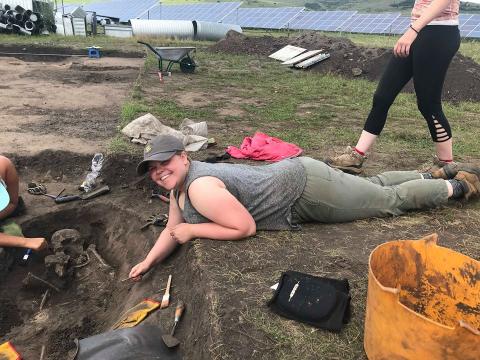Student Guest Post: Elizabeth McGuire on Molecular Methods to Map Migration

During the fall semester (Sept-Dec 2018), students from Bryn Mawr and Haverford helped to clean and catalogue the remains at Rutgers-Camden as part of a praxis course led by Professor Maja Šešelj. The following post if from one such student --- Bryn Mawr student Elizabeth McGuire.
Molecular Methods to Map Migration
By Elizabeth McGuire, Bryn Mawr College
When anthropologists examine human skeletal remains, they can tell a lot about those individuals by visually examining, measuring, and scoring the bones in order to determine age, sex, and geographic ancestry. In order to explore more detailed questions about people’s lived experiences that cannot be answered by external examination of bones or teeth, anthropologists often turn to molecular methods originally developed in other sciences, such as chemistry or geology. One of these useful approaches is stable isotope analysis. Isotopes are variants of chemical elements that differ from each other based on the number of neutrons present in the atom’s nucleus which therefore as a result, have different atomic masses. The proportions of stable isotopes—isotopes that do not decay over time—allow bioarchaeologists to better understand aspects of an individual’s life including diet and history of migration. This is made possible because even though isotopes exist everywhere, the proportions that they occur in differ depending on the climate zone and ecosystem. The isotopic ratios of our environment become incorporated into our bodies over time through the food and water we consume. Bioarchaeologists can analyze the ratios present in human bone and make inferences about past diet and mobility based on previously determined values considered to be representative of a particular time and place. In case of the Arch Street remains, this type of analysis could help us learn more about the demographics of the late 18th and early 19th century cemetery population of the First Baptist Church in Philadelphia.
In order to examine the proportions of stable isotopes in human and animal bone or teeth, a small sample of the material needs to be taken. This sample is then treated. It may for example, in the case of carbon and nitrogen isotope analysis, be washed in hydrochloric acid in order to prepare it for processing. This sort of preparation is done in order for the bone collagen—the organic, non-mineral, part of the bone—to be extracted from the mineral components. The collagen is then analyzed and weighed through mass spectrometry. Mass spectrometry measures both the mass and concentration of atoms and molecules present in the bone collagen. These measurements are then compared to international standards, which are developed and maintained by the International Atomic Energy Agency in Vienna. The use of such standards is significant for anthropological studies because it allows archaeological sites to be compared. The most commonly used isotopes in such analyses include carbon, 13C and 12C, nitrogen, 15N and 14N, oxygen, 18O and 16O, and strontium, 87Sr and 86Sr. Carbon and nitrogen are used to investigate diet, while strontium and oxygen are primarily used to trace mobility and movement in the past.
There is a direct relationship between food consumed and the isotopic signature left behind in our bone collagen (FIG 1). Carbon isotope analysis informs our understanding about plants, which can be divided into two major groups based on the way that they photosynthesis. Approximately 95% of plants are C3 plants. For example, rice, wheat, and woody trees are categorized as C3 plants. C4 plants are differentiated because they evolved an additional pathway through photosynthesis as an adaptation to hot and dry climates. Maize (corn) and sorghum, notable domesticates, are C4 plants. By analyzing carbon signatures, we can tell the types of plants that an animal consumed. Further analyses of nitrogen allow us to situate our studies in relation to trophic level (the organism’s place in the food chain.) As plants grow, they take in nitrogen from microorganisms and nutrients in the soil. When animals or other organisms consume those plants, they take in that isotopic signature. Predators consuming other animals, rather than plants directly, have a comparatively higher 15N values. Through investigating subsistence strategies and dietary habits of past populations, bioarchaeologists can better understand the ways in which past populations interacted with their environment and exploited ecological niches.
Strontium and oxygen, on the other hand, can be used to trace mobility in the past because the isotopic ratios present in our bone and enamel reflect our immediate environment. We can determine whether an individual was “local” to the area or not by comparing the isotopic ratio range of the region to the ratio present in the individual. To determine what is considered within the range of variation for a given region, we analyze extensive samples of groundwater and underlying rock formations, so that we have a complete pictures of the isotopic signatures of a particular geographic location. Isotopes do not just inform our understanding of where the person lived around the time they died; it is also possible to infer childhood residency of individuals. This is done through analyzing isotopic signatures present in bone and enamel. Enamel does not remodel—that is to say, it does not microscopically wear and repair—in the way that bone does, so it retains the isotopic values incorporated during tooth formation in childhood. If the range of values present in the bone and enamel are very different, we can conclude that the individual spent an earlier portion of their life in a different location from where they were buried.

Stable isotope analysis has the potential to help us learn more about the individuals associated with the Arch Street Project. These methods could help us work towards a more holistic understanding of the cemetery and in turn, a cross section of Philadelphia’s population at the time. The isotopic ratios present in their bones would allow us to determine whether the individuals buried were local to the area or not. We could also investigate components of their diet. Such work with the Arch Street Project material would significantly advance our understanding of the people buried here and provide insight into their life experiences.
References
Bogaard, Amy and Outram, Alan. (2013) Palaeodiet and beyond: stable isotopes in bioarchaeology,World Archaeology, 45:3, 333-337
Bentley, R.A., 2006. Strontium isotopes from the earth to the archaeological skeleton: a review. Journal of Archaeological Method and Theory 13: 135–187.
Leatherdale, Alexander J. (2013) "Interpreting Stable Carbon and Nitrogen Isotope Ratios in Archaeological Remains: An Overview of the Processes In uencing the δ13C and δ15N Values of Type I Collagen," Totem: e University of Western Ontario Journal of Anthropology: Vol. 21: Iss. 1, Article 5.
Machicek, Michelle. “Isotope Analysis.” PBS, Public Broadcasting Service, 2014, www.pbs.org/time-team/experience-archaeology/isotope-analysis/.
Schwarcz, H.P., White, C.D., and Longstaffe, F.J. 2010. Stable and Radiogenic Isotopes in Biological Archaeology: Some Applications. In J.B. West, G.J. Bowen, T.E. Dawson, and K.P. Tu (Eds.) Isoscapes: Understanding movement, pattern, and process on Earth through isotope mapping. New York: Springer Science + Business Media B.V.
